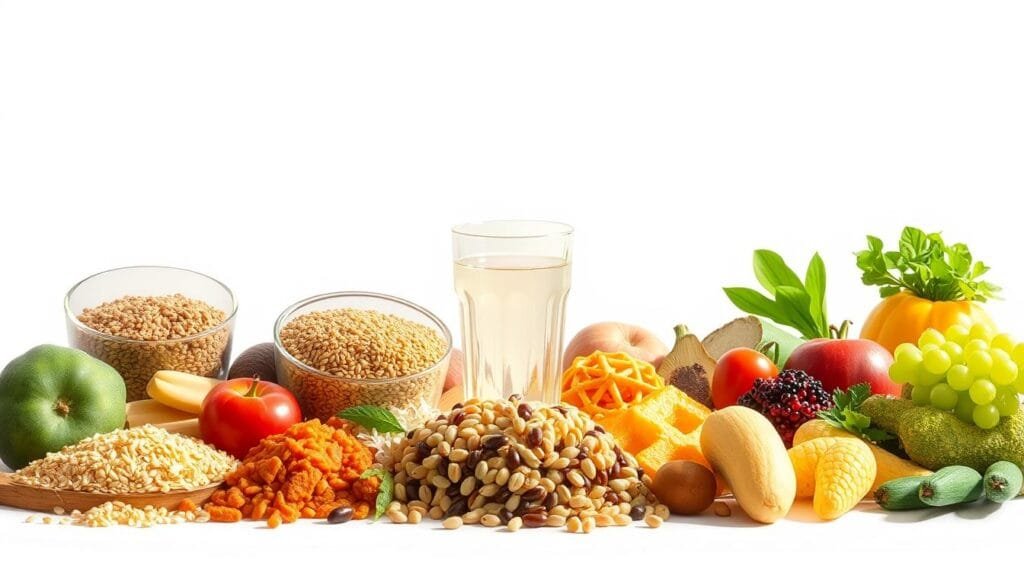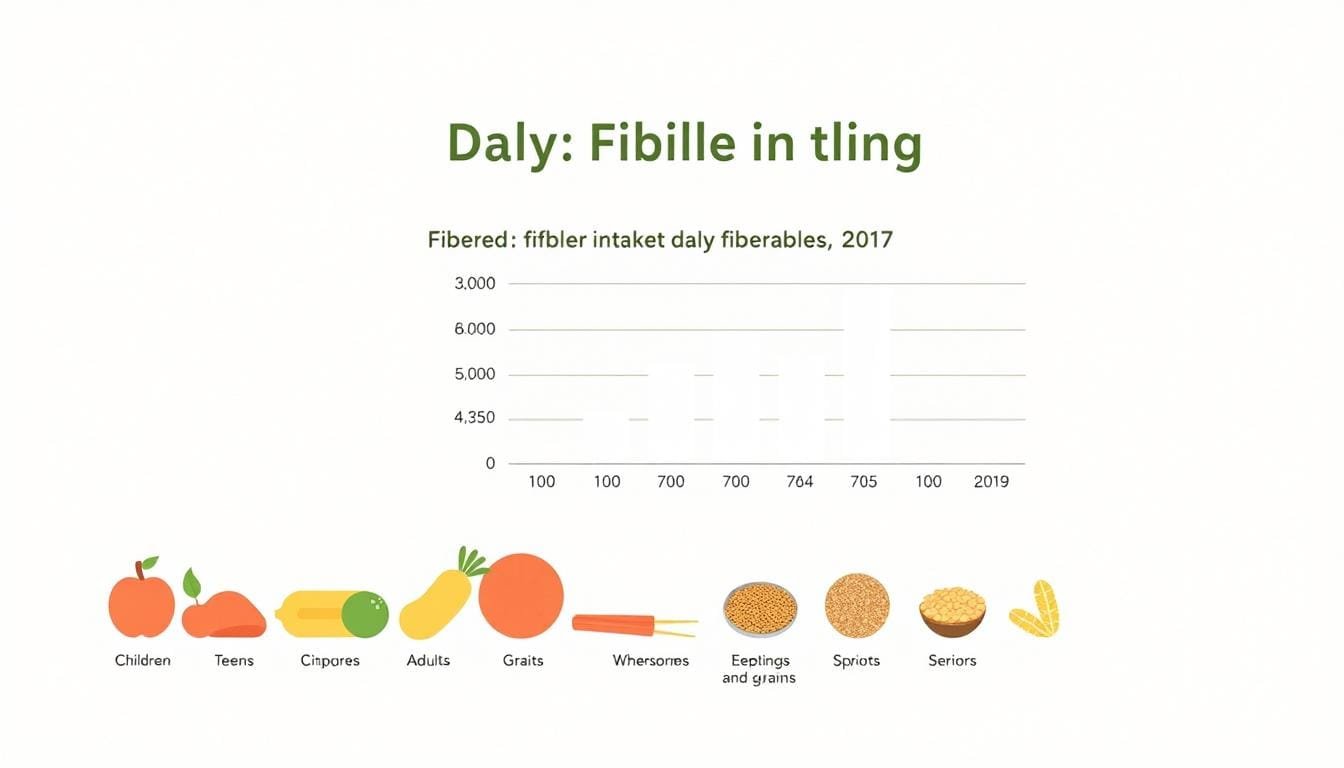Currently Empty: RM0.00
Most people underestimate the importance of dietary fiber in their meals. Studies show the average American consumes only 16 grams daily—far below recommended levels. But why do needs change over time?
Men and women require different amounts, and age plays a crucial role. For instance, younger adults often need more due to active lifestyles, while older adults benefit from its digestive support. Yet, many struggle to meet these targets.
Ignoring proper fiber intake can lead to long-term health risks. The good news? Small adjustments in diet can bridge this gap. Wellness Concept offers tailored advice to help individuals optimize their nutrition.
Key Takeaways
- Average fiber consumption falls short of USDA guidelines.
- Needs vary based on gender and life stage.
- Consistent intake supports digestion and overall wellness.
- Personalized plans simplify meeting daily targets.
- Whole foods are the best sources for lasting benefits.
How Much Fiber Per Day by Age? Official Guidelines
Official nutrition guidelines highlight distinct fiber needs across different life stages. These dietary guidelines ensure optimal digestion, energy, and long-term health. Needs vary from toddlers to seniors, reflecting metabolic and lifestyle differences.
Fiber Recommendations for Adults
Men and women have different requirements. For example, women over 51 need 22 grams daily, while men in the same age group require 28 grams. Younger adults often need slightly more due to higher activity levels.
Fiber Needs for Children and Teens
Growing bodies demand precise nutrition. Toddlers (1–3 years) need 14 grams, while teens require 25–31 grams. Gender differences emerge in adolescence, with boys often needing more.
Adjusting Fiber Intake for Seniors
Metabolism slows with age, reducing calorie needs. Seniors may require slightly less fiber but still benefit from its digestive support. Hydration becomes crucial to prevent discomfort.
| Age Group | Daily Fiber (grams) |
|---|---|
| Children 1–3 | 14 |
| Teens 14–18 | 25–31 |
| Women 51+ | 22 |
| Men 51+ | 28 |
Research shows consistent fiber intake lowers chronic disease risks. For personalized advice, explore our guide on fiber health benefits.
Why Fiber Is Essential for Your Health
Modern research reveals fiber as a powerhouse for gut health and disease prevention. Its health benefits stretch far beyond digestion, influencing immunity, heart health, and even appetite control. Understanding these roles helps prioritize fiber-rich foods daily.
Digestive and Gut Health Benefits
Fiber fuels beneficial bacteria in the gut microbiome, which ferment certain fibers into short-chain fatty acids. These compounds strengthen the intestinal barrier and reduce inflammation. Studies suggest this process may enhance immune function by up to 30%.
Reducing Chronic Disease Risks
Regular fiber intake slashes chronic disease risks significantly. The FDA notes soluble fiber (like beta-glucan in oats) lowers LDL cholesterol by 5–10%. NIH research also links high-fiber diets to a 22% lower stroke risk.
Colorectal cancer rates drop by 40% with adequate fiber, per the British Dietetic Association. This protective effect stems from fiber’s ability to speed toxin removal and reduce gut inflammation.
Weight Management and Satiety
Viscous fibers like those in chia seeds form a gel-like substance, slowing digestion and prolonging fullness. This mechanism helps regulate weight by reducing calorie intake naturally.
Oats, lentils, and apples are top satiety-boosting foods. Their high fiber content stabilizes blood sugar, preventing energy crashes and overeating.
Top High-Fiber Foods to Include in Your Diet
Boosting fiber intake starts with smart food choices that pack a nutritional punch. These options not only meet daily targets but also add flavor and variety to meals. Whether fresh, frozen, or pantry staples, each source offers unique benefits.
Fiber-Rich Fruits and Vegetables
Fruits like pears (5.6g each) and raspberries (8g per cup) are sweet ways to add fiber. Vegetables such as broccoli (5g per cup) and carrots (3.6g per cup) work well in salads or snacks.
Fresh and frozen options often have similar fiber content. For example, frozen peas retain 7g per cup—just like fresh ones.
Whole Grains and Legumes
Whole grains like quinoa (5g per cup) and oats (4g per serving) fuel energy sustainably. Legumes are fiber powerhouses—lentils deliver 15.6g per cooked cup.
Try black bean tacos for a 12g fiber meal. Soaking legumes reduces cooking time and enhances digestibility.
Nuts, Seeds, and Other Surprising Sources
Chia seeds (8.4g per tablespoon) and almonds (3.5g per ounce) make easy toppings. Even dark chocolate offers 3.1g per ounce—a tasty bonus.
Watch for misleading “high fiber” labels on processed bars or cereals. Always check the nutrition facts panel.
| Food | Serving Size | Fiber (g) |
|---|---|---|
| Lentils | 1 cup cooked | 15.6 |
| Chia Seeds | 1 tbsp | 8.4 |
| Raspberries | 1 cup | 8 |
| Pear | 1 medium | 5.6 |
| Quinoa | 1 cup cooked | 5 |
| Broccoli | 1 cup chopped | 5 |
| Oats | ½ cup dry | 4 |
| Almonds | 1 oz | 3.5 |
| Carrots | 1 cup raw | 3.6 |
| Dark Chocolate | 1 oz | 3.1 |
Mix these foods into smoothies, salads, or soups for effortless fiber boosts. Small swaps—like whole-grain pasta instead of white—add up quickly.
How to Increase Your Fiber Intake Safely
Smart adjustments make fiber boosts comfortable and sustainable. According to IFFGD research, sudden spikes may cause 300% more bloating. A gradual approach helps the gut adapt while maximizing benefits.

Gradual Incorporation Tips
Start by adding 5 grams daily to your current intake. This gives digestive enzymes time to adjust. Track progress with apps like MyFitnessPal for consistent improvement.
This 7-day plan prevents discomfort:
| Day | Added Fiber | Sample Addition |
|---|---|---|
| 1-2 | +5g | 1 pear or ½ cup lentils |
| 3-4 | +10g | 1 apple + ¼ cup almonds |
| 5-7 | +15g | 1 cup raspberries + ½ cup quinoa |
Meal Planning for Balanced Fiber
A 30g diet without supplements is achievable with whole foods. Try this daily template:
- Breakfast: Oatmeal with chia seeds (10g)
- Lunch: Lentil soup with whole-grain bread (12g)
- Dinner: Roasted veggies with quinoa (8g)
Hydration and Fiber: Why Water Matters
Fiber absorbs water to form soft bulk. Aim for 8+ glasses daily to prevent constipation. Herbal teas count toward this goal.
Psyllium husk supplements shouldn’t replace food sources. Overuse may cause dependency and nutrient malabsorption. Focus on varied plant foods instead.
Pair these strategies with consistent hydration for seamless adaptation. The gut typically adjusts within 2-3 weeks with proper execution.
Soluble vs. Insoluble Fiber: What’s the Difference?
Not all fiber works the same way in the body—understanding the difference matters. These two types play distinct roles in digestion and disease prevention. While both promote health, their mechanisms vary significantly.
Roles and Benefits of Each Type
Soluble fiber dissolves in water, forming a gel that slows digestion. This type helps:
- Lower LDL cholesterol (beta-glucan in oats reduces it by 5-10%)
- Stabilize blood sugar levels
- Feed beneficial gut bacteria through fermentation
Insoluble fiber adds bulk to stool and speeds transit time. Key benefits include:
- Preventing constipation (wheat bran increases stool weight by 127%)
- Reducing diverticulosis risk
- Creating short-chain fatty acids that protect colon cells
“Regular oat consumption can significantly improve cholesterol profiles due to soluble fiber content.”
Best Food Sources for Both
Many foods contain both soluble vs insoluble fibers in varying ratios. Apples showcase this synergy—pectin (soluble) in flesh and cellulose (insoluble) in skin.
| Type | Top 5 Sources | Key Benefit |
|---|---|---|
| Soluble | Oats, citrus fruits, beans, flaxseeds, Brussels sprouts | Slows sugar absorption |
| Insoluble | Whole wheat, celery, nuts, cauliflower, potato skins | Promotes regularity |
| Both | Apples, carrots, peas, barley, psyllium husk | Full-spectrum digestion support |
For optimal health, include both types daily. Fermentable fibers (like those in garlic and onions) offer additional benefits by nourishing gut microbiota. This dual approach maximizes protection against chronic diseases.
Symptoms of Too Much Fiber and How to Avoid Them
While fiber offers numerous health benefits, excessive amounts can trigger uncomfortable symptoms. Consuming over 70 grams daily—far above the 25–40 gram ideal range—may strain the bowel. The gut reacts differently during initial adaptation versus true intolerance.

Common Digestive Discomforts
Mild to moderate symptoms often resolve within 48 hours. Six key signs include:
- Bloating and gas: Fermentation in the colon produces excess air
- Constipation: Without enough water, fiber hardens stool
- Abdominal cramps from sudden bulk increases
- Loose stools if soluble fiber dominates
- Temporary nausea during adjustment periods
- Reduced appetite due to prolonged fullness
First-aid measures help ease discomfort:
- Drink warm water with lemon to stimulate motility
- Try gentle yoga poses like child’s pose
- Reduce fiber intake by 50% for 1–2 days
When to Seek Medical Advice
Certain red flags demand prompt medical advice. Mayo Clinic warns that extreme cases (>100g/day) carry obstruction risk. Emergency signs include:
- Vomiting alongside constipation
- Blood in stool or black, tarry bowel movements
- Inability to pass gas for 12+ hours
| Symptom Severity | Mild Cases | Severe Cases |
|---|---|---|
| Gas and bloating | Lasts | Persists beyond 3 days |
| Bowel changes | Adjusts in 1 week | Complete blockage |
| Pain level | Dull discomfort | Sharp, localized pain |
For urgent concerns, Wellness Concept’s nutritionists provide WhatsApp support within 2 hours. Most cases resolve by temporarily reducing high-fiber foods and increasing hydration.
Consultation and Contact Details
Personalized nutrition guidance helps individuals meet their specific dietary needs effectively. Wellness Concept offers tailored support to simplify health goals, from fiber tracking to meal planning. Their team of certified nutritionists provides evidence-based strategies for lasting results.
Expert Support When You Need It
Clients receive free 15-minute assessments via WhatsApp (+60123822655). This service includes:
- Quick fiber intake evaluation
- Customized food suggestions
- Local Malaysia-focused advice
Flexible Scheduling Options
Standard business hours accommodate busy lifestyles:
- Weekdays: 9:30 AM–6:30 PM
- Weekends: 10:00 AM–5:00 PM
Holiday hours adjust for Ramadan and Chinese New Year. Consultation visits in Pj and other branches are available—view locations here.
New clients receive a downloadable fiber tracker to monitor progress. For personalized advice, message Wellness Concept directly via WhatsApp or visit their clinics.
Conclusion
Meeting daily fiber targets supports long-term health at every life stage. Adults thrive on 25–34 grams, while kids need 14–31 grams based on growth needs. These numbers aren’t just guidelines—they’re tools for preventing disease and maintaining energy.
The right diet rich in whole foods offers more than digestion benefits. It helps manage weight, lowers chronic disease risks, and keeps the gut balanced. Pairing increased intake with proper hydration ensures comfort and effectiveness.
Wellness Concept simplifies this journey with personalized plans. Their experts tailor advice to individual needs, making goals achievable. For a quick fiber audit, message them today.
Small changes create lasting impacts. Start optimizing your nutrition now.
FAQ
What are the daily fiber recommendations for adults?
Women should aim for 25 grams, while men need around 38 grams. Those over 50 require slightly less—21 grams for women and 30 grams for men.
How much fiber do children and teens need?
Kids aged 1–3 need 19 grams, 4–8 years require 25 grams, and teens should get 26–38 grams depending on gender and activity level.
Why is fiber important for digestion?
It supports gut health by feeding beneficial bacteria, preventing constipation, and promoting regular bowel movements.
What foods are highest in fiber?
Berries, lentils, quinoa, chia seeds, broccoli, and almonds are excellent choices. Whole grains like oats also pack a punch.
Can too much fiber cause problems?
Excessive intake may lead to bloating or gas. Increase gradually and drink plenty of water to ease digestion.
What’s the difference between soluble and insoluble fiber?
Soluble (found in apples, beans) helps lower cholesterol, while insoluble (in whole wheat, celery) aids digestion by adding bulk.
How can seniors adjust their fiber intake?
Focus on softer options like cooked veggies or oatmeal, and consult a doctor if digestive sensitivity arises.
Does fiber help with weight management?
Yes! High-fiber foods keep you full longer, reducing overeating and supporting healthy metabolism.



